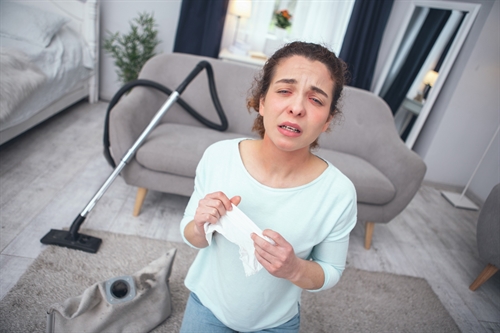Your home is meant to be a haven – but for some people the home environment triggers allergies. Some common household allergens include:
- mould
- dust mites
- new carpets
- cleaning products.
But there are some easy ways to reduce the impact of these allergens.
Moulds and fungi
Mould and fungi reproduce via spores, tiny dusty particles that are not visible to the naked eye. Spores can trigger an immune response in some people. It may cause respiratory symptoms like coughing and sneezing; or watery eyes. According to the charity Asthma UK 42% of people with asthma believe that mould triggers their symptoms.
Moulds and fungi thrive in warm, damp environments indoors. In houses mould can grow:
- behind tiles
- on flooring
- on wallpaper
- on window frames.
Mould is particularly active during a sudden rise in temperature in a damp environment. So if you are sensitive to fungal spores, your symptoms might get worse when the heating is turned on in a damp house. Another trigger is laundry drying on radiators.
We’ve got a blogpost about keeping mould and mildew out of your possessions, which may be of help. But here are some more tips to prevent mould at home.
Keep an eye out for leaks, for example, under the sink, around appliances like the fridge, dishwasher and washing machine; by the hot water tank; and in the bathroom. Repair these quickly, as mould thrives in damp enclosed spaces.
Ventilation is also important to reduce damp. Open windows regularly and make use of an extractor fan in the kitchen and bathroom. Keep lids on pans when cooking, too.
Your laundry habits can make your home fungus friendly. For example, drying clothes indoors makes for a damp environment that mould loves. So use an outdoor washing line or a tumble dryer.
Also only store completely dry clothes and avoid packing wardrobes too tightly. Consider moving out-of-season clothes into storage – the climate-controlled environment of a storage unit will prevent the growth of mould. Insurance will probably be mandatory on your unit – but you don’t have to take your storage company’s offering. Get a quote from Store and Insure.
Dust
Dust itself shouldn’t trigger allergies – but the dust mites that live it in might. Many people are sensitive to dust mite poo. Dust mites are too small to see, and their droppings are even smaller. Careful cleaning can reduce the amount of dust in your house, but Asthma UK says there is no consistent evidence that this helps with allergy symptoms. But if you find reducing dust helps you, consider decluttering as a first step, as this will make it easier to maintain a low-dust cleaning routine.
New carpets and furniture
New carpets and furniture give off volatile organic compounds (VOCs) and these may trigger allergies in some people. If you know that ‘new carpet’ smell causes you problems with your allergies, you can take a few steps to reduce your symptoms. For example, ask the shop to unroll and air your new carpet before they deliver. And air the new item in a well-ventilated room before using.
Household cleaning products
Unfortunately household cleaning products may be a source of VOCs, too, so they can trigger allergies. If this is a problem for you, switch to products without perfume, and avoid sprays. Open a window while you clean and consider paying for a cleaning service. Use cleaning products sparingly and try going without – a damp cloth and elbow grease may be just as effective.
It may take a bit of trial and error to keep your allergies at bay – but it’s your home, so do whatever you need to do to be comfortable.



